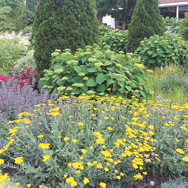Tips for the care and robust growth of ... PERENNIALS

By LINDA C. DOLAK
OSU Master Gardener Volunteer
What do we do with perennials? Do we deadhead, deadleaf, disbud, pinch, cut back or thin?
The answer: All of the above.
Using these techniques will encourage the plants to bloom longer and will improve their appearance.
A perennial plant, if well taken care of, will continue to bloom for at least three years. At that time, they may need to be divided or replaced. Do this when the plants are dormant, just before a new growth or in the fall so they can become established before the first frost.
Perennials whose stems live from season to season, and continue to grow are known as woody perennials. Herbaceous perennials are those plants that will bloom every year.
Deadheading is removing spent flowers after the blooms begin to fade and appear like they are starting to dry. Deadheading will also produce additional flowering. Some perennials, if left to seed, will spread where you may not want them. Some of these include flowering onions, golden marguerite, foxglove, coneflower, columbine, balloon flower and Siberian iris.
Dead leafing is simply removing the dead leaves to make room for new foliage. This will improve both appearance and health of the plant.
Disbudding a plant is removing the side buds, producing a limited number of large flowers rather than several smaller flowers.
Instead of cutting off spent flowers simply remove side buds and leave one terminal bud. This can direct the plant’s energy toward growing just a few buds or one large bud. Remove side buds when they are about the size of a pea.
Pinching removes the terminal bud, or tip of the shoot, along with the first set of leaves. When pinching, it is only necessary to use fingers or a fingernail to remove this portion of the stem because it is often soft and fleshy.
Even when you are removing potential flowers, the plants that are pinched back will actually produce more flowers during the growing season. After the plant has been pinched, it will grow new lateral stems, and each of these new stems usually sets flower buds. Also, this process will prevent some herbaceous plants from growing tall and spindly. Be sure to pinch on all sides so flowering is uniform. Some perennials to pinch include Bellflowers, Bee-Balm, and Coneflowers.
Cutting back the entire top of a declining perennial to the ground or near to the ground can promote strong new growth. This technique can even extend the life of some perennials, including coreopsis that have flowered to exhaustion and can stagger flowering if done at weekly intervals. Cutting back also is used to prevent plants from becoming woody or lanky.
Thinning perennial plant stems is the process of removing one-third of the stems at ground level when the plant reaches approximately one-fourth to one-third of its size.
The space created between stems increases so the entire plant is less dense, the shape of the plant is more attractive, and can increase flower size because the plants will be rejuvenated by the new stem growth after the thinning process.
These processes will help keep your perennials healthy, but wet years such as we are experiencing now can cause disease issues to even the healthiest of perennials.
One of the most-common and destructive diseases that can affect perennials is botrytis blight or gray mold.
This disease is commonly found during or after cool, damp, cloudy weather. It predominantly attacks tender tissues, such as flower petals, buds, seedlings or weakened or injured tissues.
We’ve seen it a lot on rose flowers this year. It can be found everywhere plants are grown.
The infection first appears as whitish growth but soon darkens to a gray color. Smoky gray dusty spores form and are spread by wind or water.
To prevent this disease, thin your plants with pruning and practice good sanitation. All processes discussed above can help to prevent the start or spread of botrytis. Totally remove the refuse taken from plants. Do not allow cuttings to lie on the ground to encourage the start of the infection. Keep leaves dry, provide good air circulation and do not overcrowd plants.
Gray mold thrives in shaded and crowded plantings and in areas of poor air circulation. Maintain healthy plants by following the above recommended practices, especially proper irrigation and pruning to maintain healthy plants/gardens.
You can go online for great tips: http://go.osu.edu/perennialcare; http://go.osu.edu/pruningperennials; http://go.osu.edu/boto .
 43
43
